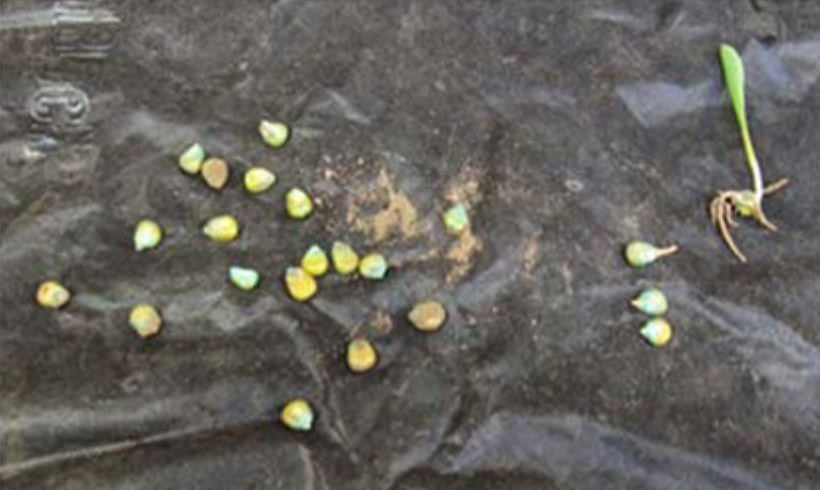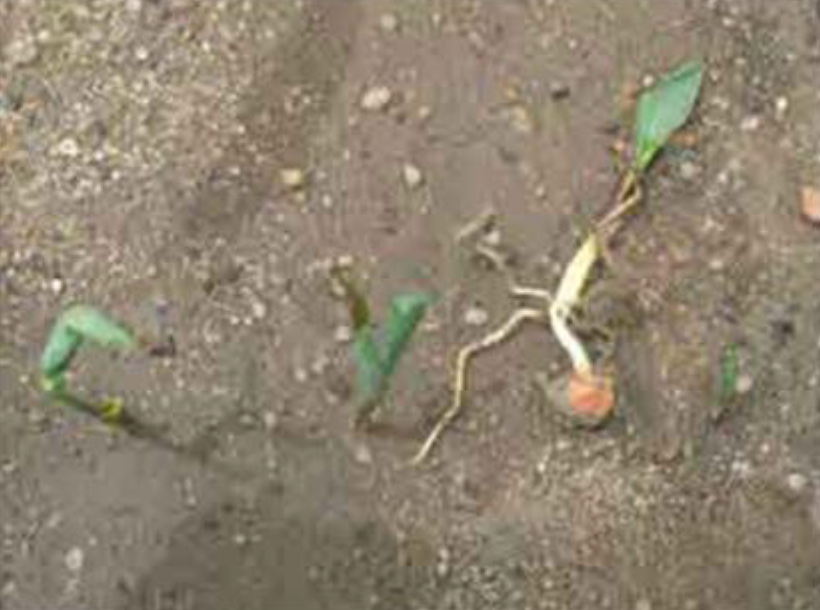⇦ Back to Fertilizer Lime Amendment Technology and Use Home
¶ Introduction
Placing fertilizer in direct seed contact (i.e., “in‐furrow” or “pop‐up” application) is a common planting practice. It can be a beneficial, but can also result in seedling damage from excess or misplaced fertilizer – ultimately affecting stand and yield. The “Rule‐of‐10” provides guidelines to help minimize the potential risk from seed‐placed fertilizer applications.
¶ A. Fertilizer “Salts”
- “Salt” often associated with common table salt (sodium chloride)
- Chemistry definition of salt: substance produced by reaction of acid with base
- “Salt” consists of positive ion (cation) of acid and negative ion (anion) of base
- Plants “require” salt?
- Effective fertilizer materials are “salts” because they dissociate into ionic forms when dissolved in water
- Solid or liquid fertilizers must dissolve in soil moisture for nutrient ions to be available for uptake by plant roots
- Certain ions have greater effect on plant tissues than others; may be potentially toxic
¶ B. Fertilizer “Salt Injury”
- After initial application, ions (“salts”) diffuse away from point of placement as fertilizer material dissolves in soil water
- Increased dissolved ion content increases salinity of soil water
- If salinity is too high, plant cells lose water to surrounding soil
- Affected plant cells initially shrink; may die
- Seedling damage from applied fertilizer results from:
- Desiccation of delicate tissues due to excess salinity in the soil water around seedling roots and shoots
- Toxicity often due to trace amounts of certain ions, primarily:
- free ammonia (NH3) ii. nitrite (NO2) iii. thiosulfate (S2O3‐2)
- nitrite (NO2)
- thiosulfate (S2O3‐2)
- Typical injury symptoms include:
- Delayed or depressed germination (see Fig. 1)
- Damaged or dead seedlings (see Fig. 2)
- Roots burned or completely dead, especially radical (first emerging root)
- Uneven emergence (see Fig. 3)
- Often is no consistent field pattern of emergence problems caused by fertilizer injury
- Injury may reduce yields because of stand loss or reduced plant population
- Injury occurs more frequently with high fertilizer rates, coarse‐textured soils, and/or dry soil conditions
¶ C. “Rule of 10” Guidelines
- Limiting rate of seed‐placed fertilizer helps avoid or minimize chances of seedling injury
- Direct seed contact possible for some crops if salt concentration is kept relatively low
- Certain fertilizer materials should NOT be placed in direct seed contact
- Limit application to maximum of 10 pounds of total fertilizer salt per acre
- Baseline standard for fertilizer in direct contact with seed (fertilizer placed in seed slice)
- Total pounds of fertilizer “salt” per acre calculated by adding applied rates of nitrogen (lb N/ac) plus potash (lb K2O/ac) plus sulfur (lb S/ac)
- Do not include phosphate (P2O5) or micronutrients in total salt calculation
- Maximum rate = 10 lb/ac of N+K2O+S
- Applicable to these standard conditions:
- 30‐inch row spacing
- Crop is field corn
- Medium‐textured to fine‐textured soils
- Adequate soil moisture
- Make adjustments to Rule‐of‐10 rates for different conditions.
- Crops other than corn
- Different row spacings
- Sandy soils
- Dry soils
- Soil moisture content affects diffusion distance and injury risk
- Lack of soil moisture limits diffusion. iii. Increases total ion concentration in soil water, so increases soil water salinity
- Increases total ion concentration in soil water, so increases soil water salinity
¶ Figure 1. Corn Seed Germination Inhibited by Seed‐ Placed Fertilizer

¶ Figure 2. Seed‐Placed Fertilizer Damaged Corn Seedlings

¶ Figure 3. Seedlings Damaged by Urea‐Nitrogen in Direct Seed Contact

¶ D. Calculation and Adjustment Examples
- Rule‐of‐10 formulas:
- Salt fraction (applied as plant food) = (%N + %K2O + %S) ÷ 100
- lb/ac material allowed = max. lb/ac salt ÷ salt fraction
- Example rate for fertilizer material with analysis of 1020‐10‐1Zn‐5Sul and 10 lb/ac max. total salt.
- (%N + %K2O + %S) = (10 + 10 + 5) = 25%
- 25% ÷ 100 = 0.25 salt fraction
- Max. ÷ 0.25 salt fraction = 40.0 lb material
- Max. of 40 lb/ac of 10‐20‐10‐1Zn‐5Sul with corn seed in 30‐inch rows
- Adjust liquid fertilizer rate for material density
- Example: density of 11.5 pounds per gallon
- 40 lb/ac ÷ 11.5 lb/gal = 3.5 gal
- Max. of 3.5 gal/ac of 10‐20‐10‐1Zn‐5Sul with corn seed in 30‐inch rows
- Row spacing adjustments
- Adjustment factor = 30 ÷ row spacing (inches) Example: 20‐inch row spacing)
- Example: 20‐inch row spacing)
- Adjustment factor = 30” ÷ 20”
- 1.5 = 30” ÷ 20”
- 3.5 gal/ac x 1.5 = 5.25 gal/ac
- Max. of 5.25 gal/ac of 10‐20‐10‐1Zn‐5Sul with corn seed in 20‐inch rows
- Adjustment factor = 30 ÷ row spacing (inches) Example: 20‐inch row spacing)
- Adjust for planting conditions
- Injury risk increases for very dry soils, very sandy soils, or very cold soils
- These conditions increase level of stress on seedlings
- Reduce application rates by 50% to 65% of normal conditions
- e.g., normal rate = 10 lb/ac total salt with good seedbed conditions and/or medium‐textured soils
- adjusted rate = 5 to 7 lb/ac total salt with very dry soils, with very cold soils, and/or with very sandy soils
- Injury risk increases for very dry soils, very sandy soils, or very cold soils
- Adjust for soil separation distance
- Separating fertilizer from seed with soil allows higher application rates
- Seed can successfully imbibe water and germinate
- Seedlings often less salt sensitive once germinated
- Can increase total salt rate between fertilizer application point and seed placement depending on separation distance
- Multiply seed‐placed rate by “2” for each inch of separation distance
- For example:
- Direct contact with seed = 10 lb/ac total salt
- 1 inch of seed:fertilizer separation = 20 lb/ac total salt (10 lb/ac x 1 inch x 2)
- 2 inches of seed:fertilizer separation = 40 lb/ac total salt (10 lb/ac x 2 inches x 2)
- 3 inches of seed:fertilizer separation = 60 lb/ac total salt = (10 lb/ac x 3 inches x 2)
- Direct contact with seed = 10 lb/ac total salt
- For example:
- Apply other adjustments as necessary
- Separating fertilizer from seed with soil allows higher application rates
¶ E. Cropping Exceptions to Rule‐of‐10
- Field corn is base crop (10 lb/ac total salt)
- Other crops are more or less tolerant to seedplaced salinity than are other crops
- Some crops are very sensitive at germination, but become more tolerant with increasing maturity
- General order of sensitivity for common agronomic crops: soybeans, cotton > sorghum > corn > small grains
- Some crops will NOT tolerate direct seed placement
- Soybeans, edible beans, peas
- Vegetable crops, including sweet corn
¶ Table 1. Maximum Suggested Rates of “Total” Fertilizer Salt
|
|
| Crop | Maximum lb/ac (N+K2O+S) |
| Alfalfa | none |
| Barley | 6 – 8 |
| Canola | 1 – 2 |
| Corn | 10 |
| Cotton | none |
| Edible Beans | none |
| Oats | 6 – 8 |
| Sorghum | 3 – 5 |
| Soybeans | none |
| Sugarbeets | 5 – 6 |
| Sweet Corn | none |
| Vegetables | none |
| Wheat | 7 – 8 |
¶ F. Fertilizer Material Exceptions to Rule‐of‐10
- Some fertilizer sources may be toxic if placed in direct seed content
- Urea as nitrogen source
- Do not apply untreated urea directly to seed
- Forms free ammonia during hydrolysis; toxic to seedlings
- Polymer‐coated urea materials may reduce risk slightly, but depends on seeding conditions
- Ammonium‐containing fertilizers as nitrogen source
- Presents potential injury risk with direct seed application
- Can form toxic, free ammonia in high pH, calcareous soil
- Includes UAN fertilizers (e.g., 28‐0‐0, 32‐0‐0)
- UAN = urea‐ammonium‐nitrate
- Presents potential injury risk with direct seed application
- Thiosulfate fertilizers as sulfur source
- Do not place thiosulfate materials in direct seed contact
- Ammonium thiosulfate, ATS, 12‐0‐0‐26sul
- Potassium thiosulfate, KTS, 0‐0‐28‐10sul
- Thiosulfate ion is very toxic to plant tissues
- Do not place thiosulfate materials in direct seed contact
- Certain micronutrient materials
- Avoid direct seed placement with boron fertilizers
- Avoid very high micronutrient rates
- e.g., University of Minnesota: stand reduction from 12 quarts of chelated zinc applied in-row
¶ References
Bly, A. 2015. “What you need to know about sorghum nutrient requirements” in No‐ Till Farmer. South Dakota State Univ. Extension. https://tinyurl.com/s8njrdx
Canola Council of Canada. 2017. Seed and Fertilizer Placement in Canola Encyclopedia. https://www.canolacouncil.org/canola‐encyclopedia/plant‐ establishment/seed‐and‐fertilizer‐placement/
Cattanach, et. al. 1991. A.G. Dexter, and E.S. Oplinger Alternative Field Crops Manual,CenterforNewCrops&PlantProducts,Sugarbeets. Purdue University http://www.hort.purdue.edu/newcrop/afcm/sugarbeet.html accessed 29 Sept 2010.
Franzen, D. 2015 Fertilizer Application With Small‐grain Seed at Planting. Pub. SF1751. North Dakota State Univ. Extension. https://www.ag.ndsu.edu/pubs/plantsci/soilfert/sf1751.pdf
Kaiser, D. 2015. Assessing Damage From In‐Furrow or Pop‐Up Starter Fertilizer for Corn. Univ. of Minnesota Ext., Minn. https://blog‐crop‐news.extension.umn.edu/2015/04/assessing‐damage‐from‐in‐furrow‐or‐ pop.html
Labowski, C. 2015. Safe reates of seed placed starter fertilizer. Integrated Pest & Crop Mgmt., Univ. of Wisconsin, Madison WI. https://ipcm.wisc.edu/blog/2015/04/safe‐rates‐of‐seed‐placed‐starter‐fertilizer/
Ruiz‐Diaz, D. 2019. Diagnosing corn early‐season growth problems. Agronomy eUpdate, Issue 454, 02 May 2014. Kansas State Univ. Ext. Manhattan KS. https://webapp.agron.ksu.edu/agr_social/m_eu_article.throck?article_id=222
Ruiz‐Diaz, D. 2016. Starter fertilizers for wheat can pay if used correctly. K‐State Research and Extension News. https://www.ksre.k‐state.edu/news/stories/2016/09/wheat‐fertilizer.html
Ruiz‐Diaz, D. 2019. Is there any value to starter fertilizer on soybeans? Agronomy eUpdate, Issue 745, 03 May 2019. Kansas State Univ. Ext., webapp.agron.ksu.edu/agr_social/m_eu_article.throck?article_id=2178